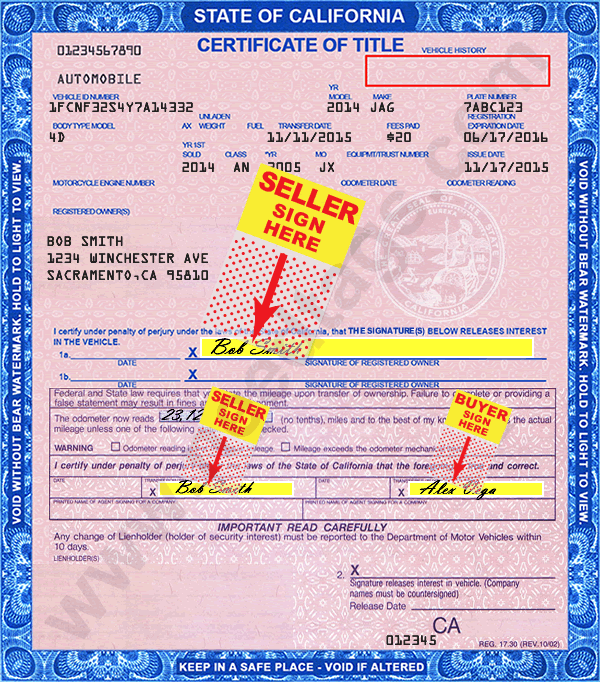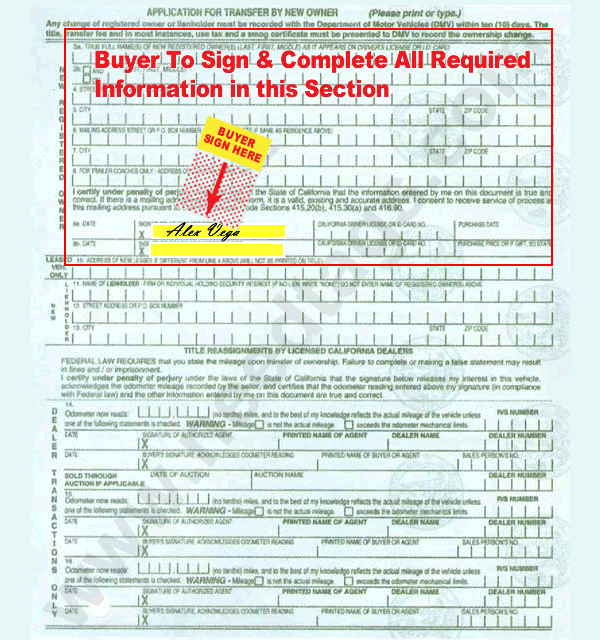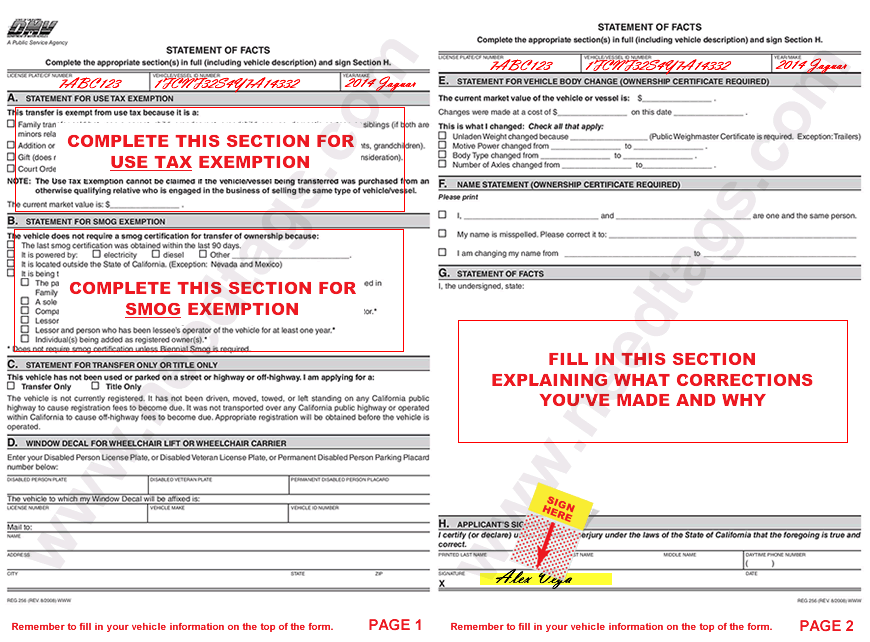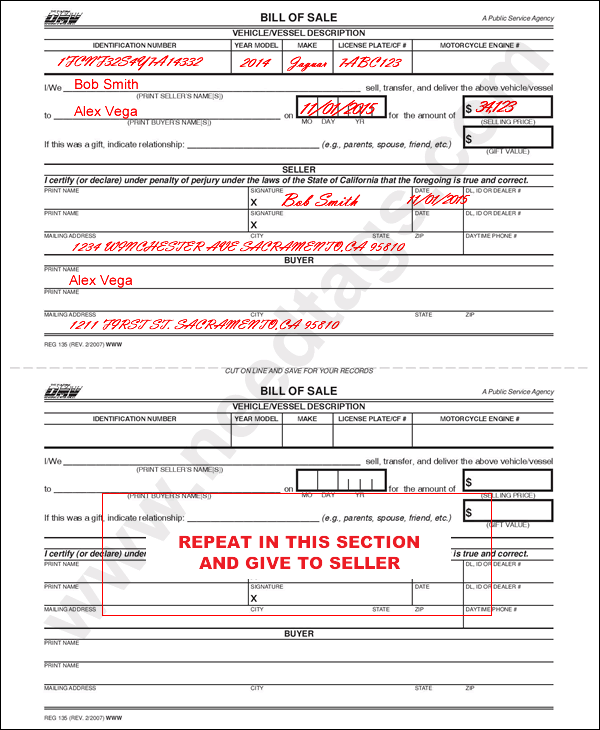How Do You Transfer a Car Title in California
A step-by-step guide to help you perform a title transfer the right way.
California DMV Title Transfer Guide for 2024
(The process outlined below applies to title transfers for both vehicles and vessels)

Do you have all your paperwork in order? Start Your Title Transfer Now
In order to transfer a vehicle from one party to another, the most important document necessary is the vehicle's title. This is an official California DMV document which identifies a vehicle and its true and registered owner(s). When selling or buying a vehicle, the certificate of title must be transferred from the old owner to the new owner. The process is referred to by the DMV as a Title Transfer, or Change of Ownership. A certificate of title may also be referred to as a pink slip. Upon submitting the required documents, a new Certificate of Title is issued and mailed out by the California DMV.
STEP 1. Ensure your title is signed in the correct places.
1(a). The person(s) named on the front of the Certificate of Title must sign this document in order to release ownership. All signatures must be in blue or black ink. A title copy is not acceptable. It must be an original.
1(b). If there are two names on the title pay attention to whether they are separated by an AND or OR. If the names are separated with an AND, both owners must sign the title in order for the DMV to accept the document. If the names are separated with an OR, either owner can sign it. If an AND nor OR exist, the title requires both owners signatures.
2. If the vehicle is model year 2010 or newer, both the seller (either seller when more than one owner exists) and buyer must complete and sign the odometer disclosure section of the title.
1(b). If there are two names on the title pay attention to whether they are separated by an AND or OR. If the names are separated with an AND, both owners must sign the title in order for the DMV to accept the document. If the names are separated with an OR, either owner can sign it. If an AND nor OR exist, the title requires both owners signatures.
2. If the vehicle is model year 2010 or newer, both the seller (either seller when more than one owner exists) and buyer must complete and sign the odometer disclosure section of the title.

3. The buyer must complete the back top portion of the title. Legibly write your resident address to ensure your new title is mailed correctly. Ensure you sign and date next to your drivers license number. If you do not have a drivers license write in your identification card number instead.
4. Indicate the date you purchased the vehicle and for how much. If the vehicle was given to you as a gift, write GIFT and indicate the vehicle's fair market value. The fair market value of a vehicle can be ascertained by looking up the sale price of comparable vehicles. Complete a Statement of Facts (REG 256) attesting the vehicle was given as a gift and no tax is due.



4. Indicate the date you purchased the vehicle and for how much. If the vehicle was given to you as a gift, write GIFT and indicate the vehicle's fair market value. The fair market value of a vehicle can be ascertained by looking up the sale price of comparable vehicles. Complete a Statement of Facts (REG 256) attesting the vehicle was given as a gift and no tax is due.

5. The rest of the back of the title is for car dealership and lienholder use. More than often this section will be completed when purchasing a vehicle from an auto dealership. They will handle the title transfer and change of ownership process for you and walk you through the steps necessary to complete the process. For private party purchases or family transfers, and when a lienholder is not involved, this section can be left blank.
STEP 2. Complete a Statement of Facts (REG 256) form, if required.
The DMV uses the Statement of Facts (REG 256) during a variety of transactions but most often when an error needs to be corrected on a DMV document, or when an exemption exists for smog check and/or Use Tax. Below we identify when you will need to complete and submit a REG 256 in order to complete a California vehicle title transfer. The REG 256 can be downloaded from our DMV forms page. You may prepare the document electronically online before printing. A REG 256 must be dated and signed in order to be accepted by the California DMV.
1. Use Tax Exemption - Certain title transfer transactions are exempt from Use Tax and require you submit a REG 256 attesting the exemption. Some examples of when you are exempt from paying Use Tax include when receiving a vehicle as a gift and/or when change of ownership occurs within family members as described by the DMV, between a spouse, domestic partner, sibling, child, parent, grandparent, or grandchild. Use Tax is also exempt when a vehicle has been inherited or acquired due to a court order, or when adding or deleting a family member's name from the title. For these transactions complete and submit a Statement of Facts form along with your vehicle title.
2. Smog Exemption - Typically a smog check is required in order to change ownership of any vehicle which is older than 4 years. In certain cases a vehicle is exempt from the smog check requirement. These include, when a transfer occurs between family members as described above, as well as when a smog certificate has been submitted to the DMV within 90 days prior to the vehicle sale/purchase date. You will most often encounter a smog check exemption opportunity when a vehicle's seller was required to (and completed) a smog inspection as part of the vehicle's registration renewal process. If your title transfer is eligible for a smog exemption, mark the appropriate box on the REG 256, sign the form and submit it with your title.
3. Document Error Correction - Any error on an official DMV document which requires correction must be corrected on said document and a Statement of Fact form be submitted along with the corrected document explaining the correction and signed by the person attesting to the error and correction. Use the blank portion on the second page of the REG 256 to write in your remarks regarding the correction. Ensure to date and sign the Statement of Facts form. Depending on the error being corrected the DMV may or may not require you have the REG 256 notarized.
Note: White-out and/or sign-overs on a Certificate of Title cannot be accepted without a Statement of Error or Erasure (REG 101) form. Download and complete the REG 101, explaining the reason for the error and include the words "NO FRAUD INTENDED" after your explanation. Mail the REG 101 along with your title document(s).
1. Use Tax Exemption - Certain title transfer transactions are exempt from Use Tax and require you submit a REG 256 attesting the exemption. Some examples of when you are exempt from paying Use Tax include when receiving a vehicle as a gift and/or when change of ownership occurs within family members as described by the DMV, between a spouse, domestic partner, sibling, child, parent, grandparent, or grandchild. Use Tax is also exempt when a vehicle has been inherited or acquired due to a court order, or when adding or deleting a family member's name from the title. For these transactions complete and submit a Statement of Facts form along with your vehicle title.
2. Smog Exemption - Typically a smog check is required in order to change ownership of any vehicle which is older than 4 years. In certain cases a vehicle is exempt from the smog check requirement. These include, when a transfer occurs between family members as described above, as well as when a smog certificate has been submitted to the DMV within 90 days prior to the vehicle sale/purchase date. You will most often encounter a smog check exemption opportunity when a vehicle's seller was required to (and completed) a smog inspection as part of the vehicle's registration renewal process. If your title transfer is eligible for a smog exemption, mark the appropriate box on the REG 256, sign the form and submit it with your title.
3. Document Error Correction - Any error on an official DMV document which requires correction must be corrected on said document and a Statement of Fact form be submitted along with the corrected document explaining the correction and signed by the person attesting to the error and correction. Use the blank portion on the second page of the REG 256 to write in your remarks regarding the correction. Ensure to date and sign the Statement of Facts form. Depending on the error being corrected the DMV may or may not require you have the REG 256 notarized.
Note: White-out and/or sign-overs on a Certificate of Title cannot be accepted without a Statement of Error or Erasure (REG 101) form. Download and complete the REG 101, explaining the reason for the error and include the words "NO FRAUD INTENDED" after your explanation. Mail the REG 101 along with your title document(s).

STEP 3. Write a Bill of Sale (REG 135) and ask the seller to sign it.
This document is not required to transfer ownership of a vehicle but is highly recommended for the purpose of "proof of purchase" and record keeping. Complete a detailed bill of sale and ask the seller sign it for your protection. A Bill-of-Sale can be hand written or pre-printed, but must be signed by the seller in order to be effective. You may download a simple bill of sale prepared by the California DMV from our download DMV forms page, or you may personally draft one.
NeedTags.com® recommends you include the following important information in your bill of sale:
Give a copy of the bill of sale to the seller and keep the original for yourself. If you don't have access to a copy machine complete two copies and have the seller sign them both.
NeedTags.com® recommends you include the following important information in your bill of sale:
- Date of purchase.
- Seller name and address.
- Buyer name and address.
- Vehicle description, including make, model, year, vehicle identification number (VIN), and license plate number. You may also want to notate the vehicle's color and any distinguishing marks and/or features.
- Sale condition, i.e. sold "as-is", sold with warranty and indicating the time-period, sold with damaged engine or drivetrain, and so on.
- If the seller purchased the vehicle but never registered it in their name, the bill of sale should include the previous owner(s) information.
- The amount paid for the vehicle, including any payments made in installments or down payment.
- How payment(s) was made, i.e. cash, check, credit card or direct deposit.
Give a copy of the bill of sale to the seller and keep the original for yourself. If you don't have access to a copy machine complete two copies and have the seller sign them both.

STEP 4. Ensure the vehicle has a valid smog certificate, if required.
Unless you fall into one of the smog exemption categories (family transfer or vehicle 4 year or newer) you will need to have a valid smog certificate on record with the DMV in order to complete the title transfer process. Section 24007 (b)(2) of the California Vehicle Code states a seller is required to give a buyer a valid smog certificate when a vehicle is sold or bought. If the seller has in fact smog checked the vehicle within a 90 day period prior to selling it, and assuming the vehicle passed the inspection, the smog certificate is in the DMV computer system and you don't have to do anything more. No documentation is required. Smog certificates are electronically transmitted to the DMV by the smog station which conducts the smog inspection. Check with seller and ensure they have smog checked the vehicle you intend to or did purchase.
NOTE: If a smog test has not been performed, one will need to be obtained before your title transfer is finalized. We can begin your title transfer process to help you avoid late fees. Once you get your smog check done, we'll complete your title transfer and mail you your new registration card. In the interim, you'll receive a Report of Deposit of Fee copy, indicating you are the vehicle's new owner.
Contact the seller and advise them about CVC 24007 (b)(2). Note, a smog station will inspect a vehicle regardless of who brings it in. This allows you to undertake the smog check yourself in the event you are unable to contact the seller or the seller is unwilling to perform the smog check themselves, or if you are unwilling to allow the seller access to your vehicle since the purchase has already been made. Just keep in mind, the DMV will not complete the title transfer process, nor will they mail a new Certificate of Title unless the vehicle passes a smog test. The only way around this is to file a Non-Operation status request along with your title transfer. Find money saving smog check coupons here. If a vehicle you purchased fails the smog test and the seller is not willing to work with you to resolve the matter, you may choose to seek legal counsel for resolution advice. Most often these matters are handled through small claims court. Check your vehicle's smog check history here.
NOTE: If a smog test has not been performed, one will need to be obtained before your title transfer is finalized. We can begin your title transfer process to help you avoid late fees. Once you get your smog check done, we'll complete your title transfer and mail you your new registration card. In the interim, you'll receive a Report of Deposit of Fee copy, indicating you are the vehicle's new owner.
Contact the seller and advise them about CVC 24007 (b)(2). Note, a smog station will inspect a vehicle regardless of who brings it in. This allows you to undertake the smog check yourself in the event you are unable to contact the seller or the seller is unwilling to perform the smog check themselves, or if you are unwilling to allow the seller access to your vehicle since the purchase has already been made. Just keep in mind, the DMV will not complete the title transfer process, nor will they mail a new Certificate of Title unless the vehicle passes a smog test. The only way around this is to file a Non-Operation status request along with your title transfer. Find money saving smog check coupons here. If a vehicle you purchased fails the smog test and the seller is not willing to work with you to resolve the matter, you may choose to seek legal counsel for resolution advice. Most often these matters are handled through small claims court. Check your vehicle's smog check history here.
STEP 5. Proof of insurance is required by law in 30 days.
Proof of insurance is not immediately required to transfer title. You may change the ownership of a vehicle you just purchased without having insurance, however the California DMV does require you purchase insurance or transfer insurance from an existing policy to the new vehicle within 30 days of transferring ownership. Driving without insurance is illegal in California. It is best that you have coverage if you intend on driving on public roadways, but the DMV will not stop you for transferring the vehicle's title over to your name. If however insurance is not obtained within 30 days the DMV will suspend the vehicle's registration. If you have not yet received your new certificate of title, you may receive a notice of incomplete application instead. Financial responsibility (commonly known as insurance) is required on all vehicles, both private and commercial, and operated in California or parked on California roadways. Insurance carriers are required by law (CVC 16058) to electronically report vehicle insurance information to the DMV.
STEP 6. Submit your documents and receive your new title.
Once you have the required documents in order, you are ready to submit them and await receipt of the vehicle's new Certificate of Title from the CA DMV. The DMV does not issue titles in person. All titles are sent by USPS mail and to the registered owner(s) address. On the new title, the old owner(s) name will be removed and yours added. If a lienholder exists, their name will be included as well. The title will identify you as the registered owner and the lienholder as the legal owner.
How To Order: For infinitely faster service, choose to transfer your vehicle's title through NeedTags and leave the heavy lifting to us. Answer a few quick questions online, mail-in your title documents and state issued identification (overnight allowed) and get the entire process completed in minutes rather than weeks. Detailed application and mailing instruction will be emailed to you once your title transfer order is received and an experienced title specialist will be available to assist you if you run into any issues or have any questions.
Through NeedTags you simply bypass DMV lines. We will record your vehicle's title transfer within one business days of document receipt, and mail to you on that same day, your vehicle's new registration card and sticker; overnight if requested. Your request will be placed in queue for CA Certificate of Title printing through DMV headquarters immediately. This makes the process infinitely faster. NeedTags proudly leads the California vehicle registration industry in processing speed and efficiency. We can process title transfers online for all types of vehicles including motorcycles, boats, RVs, ATVs and trailers. Enjoy your vehicle safely and rest assured our team of experts have your CA title transfer transaction covered.
How To Order: For infinitely faster service, choose to transfer your vehicle's title through NeedTags and leave the heavy lifting to us. Answer a few quick questions online, mail-in your title documents and state issued identification (overnight allowed) and get the entire process completed in minutes rather than weeks. Detailed application and mailing instruction will be emailed to you once your title transfer order is received and an experienced title specialist will be available to assist you if you run into any issues or have any questions.
Through NeedTags you simply bypass DMV lines. We will record your vehicle's title transfer within one business days of document receipt, and mail to you on that same day, your vehicle's new registration card and sticker; overnight if requested. Your request will be placed in queue for CA Certificate of Title printing through DMV headquarters immediately. This makes the process infinitely faster. NeedTags proudly leads the California vehicle registration industry in processing speed and efficiency. We can process title transfers online for all types of vehicles including motorcycles, boats, RVs, ATVs and trailers. Enjoy your vehicle safely and rest assured our team of experts have your CA title transfer transaction covered.

